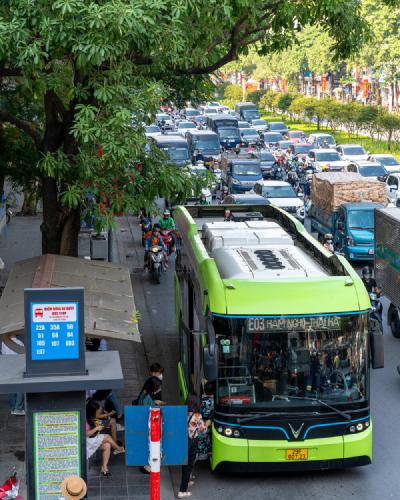ADB and its partners are transforming transport systems across Asia and the Pacific with smart city solutions, better rail systems, and more efficient transport systems—paving the way for greener, smarter, and more inclusive mobility.
cities in motion
As cities in Asia and the Pacific grow rapidly, so does the demand for more efficient, resilient, and sustainable transport systems.
To help developing member countries meet this challenge, ADB—together with Austria, Japan, the Republic of Korea, and the United Kingdom—is supporting a regional program to create more sustainable, resilient, and inclusive transport systems.
The program focuses on three key areas: improving rail infrastructure, enhancing city mobility, and reducing transport-related emissions.
rethinking urban journeys
A central part of the program is helping cities design integrated transport solutions that suit their specific needs. This means better coordination across all forms of transport—mass transit, walking and cycling paths, and last-mile connections—to create a seamless experience for users.
Electric mobility is at the heart of the program, going beyond merely swapping gasoline for electricity. It involves reimagining urban transport networks as integrated systems that prioritize inclusivity and sustainability.
One of the program’s flagship initiatives is the implementation of intelligent transport systems (ITS) that leverage data analytics for enhanced people-centred urban mobility. These smart systems enable real-time traffic monitoring, improve freight logistics with artificial intelligence, and help commuters plan the fastest and most efficient routes.
Another key output is the Green Roads Toolkit—an essential collection of good practices to guide the planning, development, and management of sustainable, eco-friendly roads. Organized around nine core dimensions, it addresses decarbonization, climate resilience, water and land management, pollution reduction, improved quality of life, biodiversity conservation, disaster preparedness, responsible sourcing of materials, and inclusive growth.
better data, better decisions
Accurate data is essential to improving transport systems. By harnessing the power of artificial intelligence and data management, ADB and partners are helping cities make transport decisions based on facts rather than assumptions.
ADB and partners developed the Asian Transport Outlook (ATO) to provide open access to transport data and policy insights. Covering 51 economies, ATO tracks over 400 national indicators and compiles information on infrastructure, transport activity, and policies.
modernizing railways with smarter tools
With funding from Austria, the program is building stronger foundations for national railways by advancing rail asset management (RAM) and life cycle costing strategies. These tools ensure better planning, maintenance, and efficiency of rail assets over time.
Participants from 21 countries—including Bangladesh, Indonesia, the Philippines, Sri Lanka, Turkmenistan, and Uzbekistan—completed an intensive RAM training with the Technical University of Graz. They were introduced to best practices in railway management and low-emission technologies, with follow-up support tailored to their local needs.
In Bangladesh, the program supported the installation and use of sensor technology to detect elephants near railway tracks. The program contributed to the SASEC Chittagong–Cox’s Bazar Railway Project Phase 1 by deploying a sensor technology capacity building expert to provide technical guidance and training for the Bangladesh Railway officials. The project promoted the use of thermal imaging and optical cameras to detect elephant movement, enhancing safety and environmental sustainability along the railway corridor.
pathways to a low-carbon future
ADB is also helping countries map out their transition to a low-carbon transport future, piloting this initiative in the Lao People’s Democratic Republic and Viet Nam. ADB collaborated with the Climate Compatible Growth Programme to facilitate two transport sector dialogues and modeling processes. This work generated decarbonization pathways that enable decision-makers to better consider the transport–energy nexus and power demand of alternate transport sector decarbonization pathways.
driving forward
By championing innovative transport solutions, ADB and its partners are not only addressing today’s mobility challenges but also shaping the future of transport across Asia and the Pacific. The program has already laid the groundwork for transformative change, with pilot projects demonstrating tangible improvements in efficiency and sustainability.
“With integrated transport solutions, electric mobility, and data-driven interventions, ADB and partners are paving the way for smarter, integrated, greener, and more efficient transport systems.”


